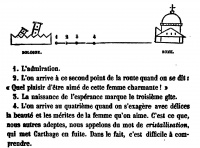Beauty is a promise of happiness
From The Art and Popular Culture Encyclopedia
(Difference between revisions)
| Revision as of 22:43, 30 December 2013 Jahsonic (Talk | contribs) ← Previous diff |
Revision as of 14:54, 22 May 2018 Jahsonic (Talk | contribs) Next diff → |
||
| Line 1: | Line 1: | ||
| + | {| class="toccolours" style="float: left; margin-left: 1em; margin-right: 2em; font-size: 85%; background:#c6dbf7; color:black; width:30em; max-width: 40%;" cellspacing="5" | ||
| + | | style="text-align: left;" |[[Immanuel Kant|Kant]]'s famous definition of the [[beauty|beautiful]]. "That is beautiful," says Kant, "which pleases without [[Interest (emotion)|interesting]]." Without interesting! Compare this definition with this other one [...] by [[Stendhal]], who once called the beautiful une ''[[Beauty is a promise of happiness|promesse de bonheur]]''. Here, at any rate, the one point which Kant makes prominent in the aesthetic position is repudiated and eliminated—le [[Disinterestedness|désinteressement]]. Who is right, Kant or Stendhal? --Nietzsche, ''[[On the Genealogy of Morality]]'' | ||
| + | |} | ||
| + | [[Image:'Bologne to Rome' page in Stendhal's On Love.jpg|thumb|right|200px|[[Stendhal]]'s depiction of the process of [[falling in love]], from ''[[On Love (Stendhal) |On Love]]'', 1822]] | ||
| {{Template}} | {{Template}} | ||
| + | '''"La beauté est une promesse de bonheur'''" (English: Beauty is a promise of happiness) is a dictum by [[Stendhal]]. It was first published as a footnote in his treatise ''[[On Love (Stendhal)|On Love]]'' (1822). | ||
| - | :[[Stendhal]], who once called the beautiful une ''[[promesse de bonheur]]''. Here, at any rate, the one point which Kant makes prominent in the aesthetic position is repudiated and eliminated—le désinteressement. Who is right, Kant or Stendhal? When, forsooth, our aesthetes never get tired of throwing into the scales in Kant's favour the fact that under the magic of beauty men can look at even naked female statues "without interest," we can certainly laugh a little at their expense:—in regard to this ticklish point the experiences of artists are more "interesting," and at any rate Pygmalion was not necessarily an "unaesthetic man." | + | The full note reads like this: |
| + | |||
| + | :"La beauté n’est que la promesse du bonheur. Le bonheur d’un Grec était différent du bonheur d’un Français de 1822. Voyez les yeux de la Vénus de Médicis et comparez-les aux yeux de la Madeleine de [[Il Pordenone|Pordonone]] (chez M. de Sommariva). [https://fr.wikisource.org/wiki/Page:Stendhal,_De_l’amour,_Lévy,_1853.djvu/64]" | ||
| + | |||
| + | It is often misattributed to [[Edmund Burke]]. | ||
| + | |||
| + | The title of ''[[Only A Promise of Happiness]]'' (2008) references the dictum. | ||
| - | :"The beautiful promises happiness." To him it is just the excitement of the will (the "interest") by the beauty that seems the essential fact. And does not Schopenhauer ultimately lay himself open to the objection, that he is quite wrong in regarding himself as a Kantian on this point, that he has absolutely failed to understand in a Kantian sense the Kantian definition of the beautiful—that the beautiful pleased him as well by means of an interest, by means, in fact, of the strongest and most personal interest of all, that of the victim of torture who escapes from his torture?—And to come back again to our first question, "What is the meaning of a philosopher paying homage to ascetic ideals?" We get now, at any rate, a first hint; he wishes to escape from a torture. | ||
| {{GFDL}} | {{GFDL}} | ||
| + | [[Category:Dicta]] | ||
Revision as of 14:54, 22 May 2018
| Kant's famous definition of the beautiful. "That is beautiful," says Kant, "which pleases without interesting." Without interesting! Compare this definition with this other one [...] by Stendhal, who once called the beautiful une promesse de bonheur. Here, at any rate, the one point which Kant makes prominent in the aesthetic position is repudiated and eliminated—le désinteressement. Who is right, Kant or Stendhal? --Nietzsche, On the Genealogy of Morality |
|
Related e |
|
Featured: |
"La beauté est une promesse de bonheur" (English: Beauty is a promise of happiness) is a dictum by Stendhal. It was first published as a footnote in his treatise On Love (1822).
The full note reads like this:
- "La beauté n’est que la promesse du bonheur. Le bonheur d’un Grec était différent du bonheur d’un Français de 1822. Voyez les yeux de la Vénus de Médicis et comparez-les aux yeux de la Madeleine de Pordonone (chez M. de Sommariva). [1]"
It is often misattributed to Edmund Burke.
The title of Only A Promise of Happiness (2008) references the dictum.
Unless indicated otherwise, the text in this article is either based on Wikipedia article "Beauty is a promise of happiness" or another language Wikipedia page thereof used under the terms of the GNU Free Documentation License; or on research by Jahsonic and friends. See Art and Popular Culture's copyright notice.


